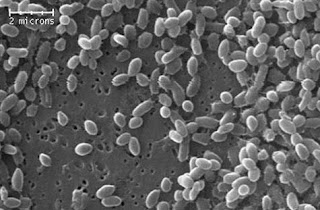"Recently, evolutionists discovered “microfossils up to almost 4.3 billion years old” in Canada.
Their article states:
four billion years—but evolution implies many, many changes over millions of years. If evolution involves substantial
change, then why are these ancient microfossils so similar to modern microbes?
The article states the microbes “are similar to the bacteria that thrive today around sea floor hydrothermal vents” and “hydrothermal vents spewing hot water may have been the cradle of life on Earth relatively soon after the planet formed.” This brings us to a second point: The hardy life forms clustered around today’s hydrothermal vents are called extremophiles. They can survive punishing temperatures, high pressure, and toxic chemicals. Were these the first forms of life on Earth—having been fashioned by time, chance, and natural processes? In our advanced 21st century, secular biologists are still unaware of life’s origin:
We should be aware that the sudden and spontaneous formation of organic life (unobserved “abiotic synthesis”) from inorganic non-life has yet to be documented either on the surface of the “primitive” Earth, or in the cracks in the ocean’s floor—the “iron-sulfur world” hypothesis. And it’s certainly never been empirically observed in a laboratory. Indeed, naturalistic philosophers despair in even defining what life actually is.
Finally, the article airily stated that the oceans “appeared.” But even water’s origin is an ongoing puzzle for the material scientist. “Astronomers [are still] looking for clues to water’s origins” stated a science news website. It recently has been suggested water covering the Earth may have had a more local origin, This is an interesting admission especially in the light of what the Apostle Paul said:
Their article states:
“It shows that some microbes have not changed significantly” since Earth’s early times, Papineau said. Earth formed about 4.5 billion years ago and the oceans appeared about 4.4 billion years ago. If the fossils are indeed 4.28 billion years old, that would suggest “an almost instantaneous emergence of life” after ocean formation, Dodd said.
It is significant that these fossil microbes apparently didn’t change after change, then why are these ancient microfossils so similar to modern microbes?
The article states the microbes “are similar to the bacteria that thrive today around sea floor hydrothermal vents” and “hydrothermal vents spewing hot water may have been the cradle of life on Earth relatively soon after the planet formed.” This brings us to a second point: The hardy life forms clustered around today’s hydrothermal vents are called extremophiles. They can survive punishing temperatures, high pressure, and toxic chemicals. Were these the first forms of life on Earth—having been fashioned by time, chance, and natural processes? In our advanced 21st century, secular biologists are still unaware of life’s origin:
How did cells arise? Of all the major questions posed by biologists, this question may be the least likely ever to be answered.
Finally, the article airily stated that the oceans “appeared.” But even water’s origin is an ongoing puzzle for the material scientist. “Astronomers [are still] looking for clues to water’s origins” stated a science news website. It recently has been suggested water covering the Earth may have had a more local origin, This is an interesting admission especially in the light of what the Apostle Paul said:
“Men, why are you doing these things? We also are men with the same nature as you, and preach to you that you should turn from these useless things to the living God, who made the heaven, the earth, the sea, and all things that are in them.” (Acts 14:15)
The biblical record is a testimony of One who made water and life..." ICR
